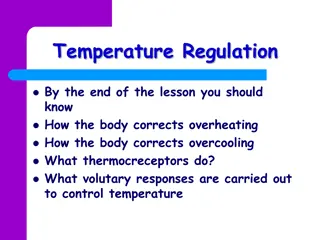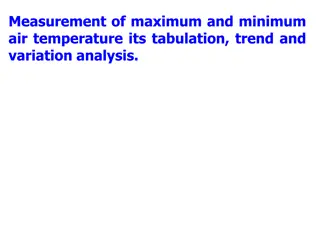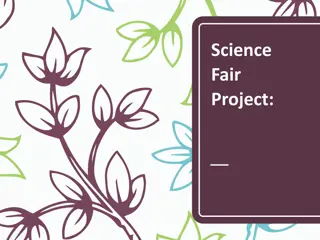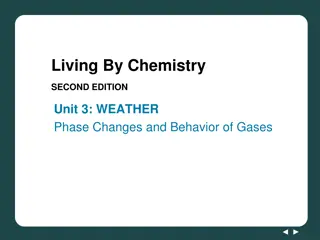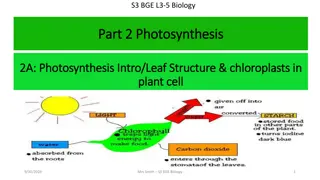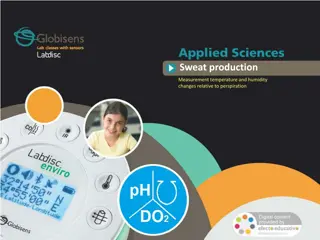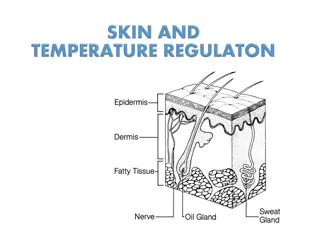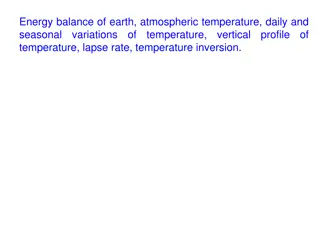Understanding the Impact of Temperature on Animals and Plants
Temperature plays a crucial role in influencing animals and plants, affecting their adaptations and biochemical processes. Animals are classified based on their ability to regulate body temperature, with terms like poikilotherm and homeotherm being redefined as ectothermy and endothermy. Ectotherms rely on external heat sources, while endotherms generate internal heat, showcasing different thermal adaptation strategies in the animal kingdom.
Download Presentation

Please find below an Image/Link to download the presentation.
The content on the website is provided AS IS for your information and personal use only. It may not be sold, licensed, or shared on other websites without obtaining consent from the author. Download presentation by click this link. If you encounter any issues during the download, it is possible that the publisher has removed the file from their server.
E N D
Presentation Transcript
Temperature relations Temp very important factor effects not only animals but also have influence on plants Varies considerably geographically Temp variations effects the animal historically but also induce adaptations in them. Also have certain biochemical effects
Temperature classification of animals Animals are categorized into groups according to the temperature inhabit and their patters of temperature regulation. Historical classification Cold blooded - animals having body temp below 5 oC Warm blooded birds & mammals b/c of few exceptions certain mammals below 5 C during hybernation e.g squirrels So this terminology was excluded & alternate classification was made
Poikilotherm (poikilo =varied) - body temperature approximates the ambient temperature. Not capable of controlling body temperature as ambient temperature varies. Cold blooded animals. Their body temperature fluctuates along with the environment so thermoconformers do not have efficient source of heat production.b/c of low metabolic activities Homeotherm (homeo = same ) - controls body temperature, keeping it relatively constant as ambient temperature varies. There fore thermoregulators. Efficient source of heat production due to high metabolic activity& by hormonal control
These terminologies were found to be ambigious b/c poikilotherms do resist the ambient temperature but to regulate the temperature they depend upon the ambient temperature. New terminologies are Ectothermy Endothermy heterothermy
Ectotherm (ecto = outside) - An animal that derives body temperature from an external heat source. Animals have low metabolic heat production Have efficient heat conduction system Higher thermal conductivity Importance of heat exchange with environment Some insects, reptiles, amphibians Classified as Heliotherms: take heat directly from sunlight e.g lizards & insects basking of insects Thigmotherms receive heat from substance or immediate environment.
Endotherm (endo = inside) - An animal that derives body temperature from internal heat production. Hav an efficient endogenous heat production Have good insulation of their body from environment thermoregulators
Heterotherm (hetero = different) - regulates body temperature when active, but allows body temperature to fluctuate with the environment when inactive. Certain insects & birds, rodents, marsupials When the birds have made enormous flight they warm up their body by muscular activity under hormonal control and body temperature may rise to 40 C & at other time it fails to do so. Is of two types
Regional Homeothermy Core body temperature Temperature at the interior of the body (thoracic and abdominal cavity, brain, etc.) Maintained within narrow margins Peripheral body temperature Temperature of integument, limbs, is not different from surrounding Tends to vary considerably Another example ---- scrotum of certain animals keep the temperature 5 C below the body temperature due to pempiniform plexus in the testis.
Temporal heterothermy The exhibition of widely different body temperatures at different times or under different conditions, as certain species of birds, marsupials, or hibernation. During these conditions animals maintain their body temp below their normal phase f activity. Metabolic heat production is reduced, Humoral agents causes the lowering of temperature. If ambient temp. decreases more than body temp. then animal start producing heat & maintain low temp. Blood supply decreases except head and brown fat--- low blood supply to pulmonary area, less oxygenation-- -acidity & decrease PH & enzymatic activity decreases.
Heat Exchange Between an Animal and its Environment
Temperature effects Temperatre effects both biochemical and metabolic changes. Thermophilic organisms can survive at very high temp. 94 95. Where as animal life prevails from -30 to 55 Temp. effects at various levels COLDER EFFECTS: Water essential component --- life ranges b/w 10 40C. Water has fascinating characteristics of freezing due to contraction and expansion properties Ice formation --- major hazards----cold death occurs WARM EFFECTS: At high temp. 02 curve goes against conditions. Its availability decreases to the tissues. Heat death High temperature strongly effects the enzyme activity and cause heat death.
ADAPTATIONS IN ECTOTHERMS In Cold Environment 1. PREVENT crystal formation The crystal formation in the cells is lethal b/c it destroys the cells. Problem is minimized in certain animals like beetles that an with stand the freezing temperature. Due to the presence of a substance in extracellular that accelarates nucleation. As a result extracellular fluid crystalize before the intracellular fluid, as water leaves the extra cellular fluid to form crystal the fluid becomes concentrated & draws water out of the cell. Which lowers intracellular freezing point. cell is avoided from destruction. Chironomus larvae can survive as low as -32C. Animals not so active ---hybernating conditions.
2. super cooling Some animlas supercooling body cooled below freezing point. Yet remain unforzen b/c of absence of ice crystals. Crystal will fail to form as long as they hav no seeds. Certain fishes at bottom of arctic live in supercooled state unless come in contact with ice cystal. 3. antifreeze substance Advanced type of adaptation Antifreeze substances like Glycerol NaCl Sugar sorbitol, inositol Antifreeze proteins Glycoproteins
The conc. Of glycerol increases during winter & animal survive at -17C Several glycoprotein has been isolated from arctic pecific & atlantic region. 200- 500 times more effective than equivalent conc. Of NaCl. Polymer of analyl-amalyl theronine also act as antifreeze substance which form glycoprotein b/c thy have N- aceyl galactose amine galactose.
ECTOTHERMS IN HOT ENVIRONMENT Evaporative Cooling depends upon ambient temp. & humidity. At high temp. low humidity high evaporation occurs. In dry conditions sweating brings more cooling. At 50C with low humidity can easily be managed as compared to 35C but high humidity. At low humidity dehydration--- animals dependent upon environment, lizards use that in high humidity, frogs secrete mucous evaporation slowly that causes cooling
2. heart rate and vascular supply Animals are poor conductor of heat. If internal tissue has high temperature then heart rate and vascular supply increases which in turn removes the heat e.g in lizards. 3. Behavioral adaptations to bask. If internal temperature is high then animals move to colder places & if feel low moves towards high temperature. Lizards use all three types of adaptations to avoid high temp.
Advantages not need to manage endogenous heat production manage with minimum budget Urothermy Stenothermy
Endotherms Generate most body heat physiologically Tend to be homeothermic regulate body temperature (Tb) by adjusting heat production therefore thermoregulators e.g birds, mammals.the body temperature of primates is 37 which is most appropriate for endogenous heat production and enzymatic activity. Tb 35 42 C. In endotherms temp regulation occurs through CNS hypothalamus Thermoreceptors in spinal cord Peripheral thermoreceptors in skin.
ENDOTHERMS IN COLD ENVIRONMENT Endotherms respond to low ambient temperatures by: Increasing heat production (thermogenesis) Limiting heat loss Lose ability of thermoregulation. Mechanism of reducing heat. 1. Decrease thermal conductance---through lower surface to volume ratio. Temperature thermoconductivity decreases with increase in size. 2. Postural adjustment. Birds retracting the head under the wings
Body Heat Retention Increased body size surface area/volume ratio Generally thicker coats Bergmann s Rule size w/ latitude
3. external insulation nesting or homing abalities, live in caves etc, arctic bear in ice caves 4. Huddling together--- live in community antarctic pegunins 5. Thick fur under skin surface 6. Reduce blood supply
Increase in endogenous heat production.---Thermogenesis Shivering Rapid contractions in groups of antagonistic muscles No useful work generated Heat liberated by hydrolysis of ATP Non-shivering Thermogenesis Enzyme systems activated that oxidize fats to produce heat Virtually no ATP production Nutritional fermentation ruminents hv efficient nutritional fermentation system bacteria digest cellulose& liberate heat energy.
Non-shivering Thermogenesis Brown Adipose Tissue (BAT) Highly vascularized, with large numbers of mitochondria Inner mitochondrial membranes contain thermogenin Allows H+ to bypass ATP synthase Protons re-enter mitochondrial matrix and bind to O2, generating heat and water Heat absorbed by blood in vasculature and distributed throughout the body
Body Heat Retention Circulation Reduced skin perfusion Limit heat loss from blood Countercurrent Exchange Heat transferred from arteries to veins Limit heat loss from extremities Absorb heat through basking Lose ability of thermoregulation and becomes heterotherms.
Endotherms in hot environment Endotherms respond to high ambient temperatures by: 1. Limiting heat gain 2. Increasing heat dissipation
Limiting Heat Gain Increased Size Large animals have large heat capacities and low surface area/volume ratios Take longer to heat up Large animals tend to have thicker pelage Insulate body from external heating
Increasing Heat Dissipation Specific heat exchange surfaces Enable heat loss through conduction/convection/radiation Thin cuticle Highly vascularized Lightly insulated Large surface areas Allen s Rule The warmer the climate, the larger the size of appendages
Evaporative Cooling Sweating Extrusion of water through sweat glands onto the skin Panting Evaporative cooling through the respiratory system surfaces Gular Flitter- heat loss from throat surface e.g chickens, pigeons, it has considerably supplied with blood supply
Sweating vs. Panting Sweating Passive (little energy expenditure) High salt loss No convection No effect on blood pH Panting Active (requires muscle contraction) No salt loss Convection increases cooling Increased ventilation pH
Panting and Brain Cooling Panting can cool brain during high levels of activity Rete mirabile heat exchange between warm arterial blood and cooled venous blood from nasal cavity Maintain brain temperature despite abnormally high body temperature
ESTIVATION Several vertebrates & invertebrates have estivation. It may be long or short. E.g snail close their shells due to enzymatic activity & remain inactive for summer. Fishes go in mud and remain inactive Similar to hibernation but differ in seasonal timing.






